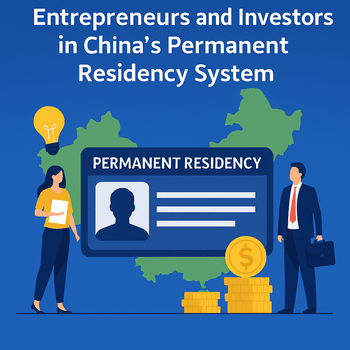
As China continues opening its doors to global talent, entrepreneurs and investors are eyeing permanent residency (PR) as a gateway to long-term stability, market access, and preferential policies.
In recent years, Beijing has rolled out region-specific pilots, point-based schemes, and specialized visa categories aimed at high-net-worth individuals and strategic innovators.
For founders scaling emerging tech, green energy developers, and investors backing China’s next unicorns, understanding both current PR channels and anticipated policy enhancements is critical.
This post unpacks existing frameworks, highlights future pathways, and offers a tactical roadmap for PR hopefuls.
Why Permanent Residency Matters for Entrepreneurs and Investors
Permanent residency in China delivers three core advantages:
1. Tax Incentives & Financial Certainty
Qualified foreign talent may enjoy a reduced personal income tax rate—sometimes as low as 15% or even 10% in the Greater Bay Area.
This can significantly lower operational costs and improve net returns for founders and managing partners.
2. Market Access & Mobility
A PR “Green Card” removes annual visa renewals, grants visa-free entry for certain countries, and streamlines family reunification, making it easier to recruit international talent and support dependents.
3. Policy Privileges
PR holders often gain priority in land use approvals, R&D subsidies, property purchase quotas, and public services (schools, healthcare), aligning closely with China’s drive to attract “innovation ecosystems” of startups and VCs.
Current Pathways: Tiered Investment Routes
China’s PR system for investors hinges on actual paid-in capital thresholds varying by region.
Below is an overview of major tiers based on Shanghai’s criteria:
| Region Category | Minimum Registered Capital | Operating Years Required | Key Industries Encouraged |
|---|---|---|---|
| Tier-1 (Shanghai, Beijing) | ≥ US $2 million | ≥ 3 consecutive years | All industries, with extra points for high-tech, fintech, biotech |
| Central China (Hubei, Anhui) | ≥ US $1 million | ≥ 3 consecutive years | Manufacturing, agriculture, emerging strategic sectors |
| Western Regions & Poverty Alleviation Zones | ≥ US $500 k | ≥ 3 consecutive years | Infrastructure, tourism, poverty reduction projects, renewable energy |
| “Encouraged” Industry Projects | ≥ US $500 k | ≥ 3 consecutive years | Foreign Investment Industry Guidance Projects (e.g., green tech, AI) |
Source: Permanent residence for foreign investors – Shanghai Municipal Government
Applicants must provide a valid passport, visa or existing residence permit, three years of tax clearance certificates, audited capital verification reports, and business licensing documents.
Spouses and unmarried children under 18 may accompany the principal applicant under the same application package.
Emerging Trends & Future Policy Enhancements
China’s next phase of residency reform is driven by four major trends:
1. Enhanced Points-Based Evaluations
The national “Golden Visa” pilots are expected to refine scoring algorithms—weighting factors like R&D spend, job creation, IP ownership, and cross-border trade volume—to expedite top-tier entrepreneurs and investors.
2. Regional Pilot Expansions
Building on successes in the Greater Bay Area and Hainan Free Trade Port, additional coastal and central provinces may launch PR accelerators.
These will likely offer lower capital thresholds for strategic sectors (biotech, semiconductors, advanced materials).
3. Sector-Specific Incentive Wedges
To align with “dual circulation” and carbon-neutrality goals, preferential PR pathways are anticipated for green energy backers, EV charging infrastructure operators, and digital economy pioneers.
4. Digital Nomad & Remote Work Visas
With the rise of remote collaboration, China may introduce a “Digital Residency” concept—granting multi-year × 90-day stays for service-trade specialists, consultants, and remote-work entrepreneurs.
These shifts aim to balance selective openness with strategic industrial development, making PR more accessible to high-impact contributors and globalized teams.
Strategic Roadmap for PR Applicants
Below is a four-step playbook to maximize your PR prospects in the evolving landscape:
| Step | Action Item | Best Practices |
|---|---|---|
| 1 | Select Optimal Region & Pathway | Map your industry focus (e.g., biotech) to regions offering pilot incentives; monitor provincial notices. |
| 2 | Align Investment with “Encouraged” Industries | Structure your capital injection to target government-backed projects (e.g., renewable energy, AI). |
| 3 | Engage Local Government & Incubators | Leverage one-stop service centers, attend local investor forums, and secure letters of support. |
| 4 | Compile & Submit Comprehensive Documentation | Use checklist from FYP 2025 guides; ensure 3 years of audited financials and clean tax records. |
Drawing on 2025’s streamlined procedures, embedding your venture in high-growth clusters (e.g., Shenzhen’s AI Valley or Shanghai’s Finance Innovation Zone) boosts your scoring in both regional and national point-based systems.
Sustaining Your Residency: Renewal & Family Extensions
Once granted, China’s PR status requires renewal every ten years, akin to the “Green Card” model in many countries.
Holders must be mindful of maintaining tax compliance and abiding by residency conditions; failure may impact renewal.
Meanwhile, PR holders can extend rights to spouses and dependents—anchoring your family’s life, education, and healthcare in China’s urban hubs.
Conclusion & Long-Term Outlook
China’s permanent residency landscape is on the cusp of greater flexibility and industry alignment.
As policy architects fine-tune point formulas, broaden regional pilots, and introduce sectoral incentives, entrepreneurs and investors with strategic foresight stand to benefit immensely.
By proactively aligning your ventures with national priorities—green tech, advanced manufacturing, digital services—you’ll not only secure PR status but also gain preferential access to China’s vast consumer market and innovation networks.
Whether you’re a serial entrepreneur eyeing the next frontier or an institutional investor backing cutting-edge startups, staying attuned to policy updates, engaging with local authorities, and structuring your investments around encouraged industries will be your compass to permanent residency success in China.
External Links & Sources
- Permanent residence for foreign investors – Shanghai Municipal Government: https://english.shanghai.gov.cn/en-GettingPermanentResidency/20231229/382070f8bbd942bc8a7c31b8073e2347.html
- How to Apply for Permanent Residency in China in 2025: Step-by-Step Expert Guide – AloneReaders: https://www.alonereaders.com/article/details/3061/how-to-apply-for-permanent-residency-in-china-in-2025-step-by-step-expert-guide
- Obtaining a Residence Permit in China – Updated Guide 2025: https://lawyerschina.net/obtaining-a-residence-permit-in-china/



